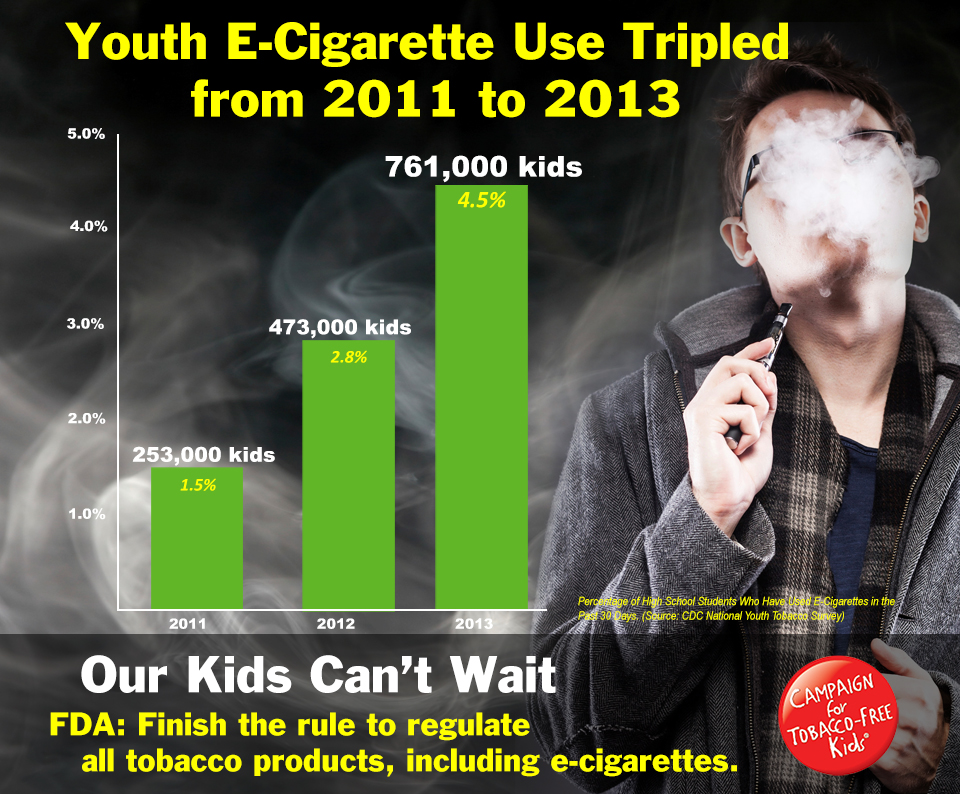New CDC Youth Tobacco Survey Should Spur FDA to Finalize Rule Regulating All Tobacco Products, Including E-Cigarettes and Cigars
Teen E-Cigarette Use Triples, Cigar Use Stays Steady Even While Cigarette Smoking Continues to Drop
November 13, 2014
WASHINGTON, DC – The 2013 National Youth Tobacco Survey released today by the CDC shows that while youth cigarette smoking continues to decline, electronic cigarette use among high school students tripled from 2011 to 2013 and there has been no progress in reducing youth cigar smoking.
These findings underscore the urgent need for the Food and Drug Administration to finalize its proposed rule to regulate all tobacco products, including e-cigarettes and cigars, in order to prevent youth use of these products. We again call on the FDA to issue a final rule by April 25, 2015 – one year after the FDA issued a proposed rule – and to close gaps in the rule by cracking down on marketing and flavors that appeal to kids. The FDA first announced in early 2011 that it planned to regulate e-cigarettes, cigars and other unregulated tobacco products, so these important public health protections are long overdue. We cannot afford more delays that allow the tobacco industry to continue targeting our kids with a new generation of unregulated tobacco products.

The FDA currently regulates cigarettes, smokeless tobacco and roll-your-own tobacco under a landmark 2009 law, the Family Smoking Prevention and Tobacco Control Act. But the FDA must assert jurisdiction over other tobacco products, including e-cigarettes and cigars, before it can regulate them, which is what the proposed rule would do.
Key findings of the new survey include:
Youth cigarette smoking continues a steady, long-term decline, again reaching a record low. In 2013, the cigarette smoking rate among high school students was 12.7 percent, down from 14 percent in 2012 and 15.8 percent in 2011 (the CDC last year published results of the 2011 and 2012 National Youth Tobacco Surveys). Since 2000, cigarette smoking among high school students has been cut by more than half (from 28 to 12.7 percent), while middle school smoking has fallen by 74 percent (from 11 to 2.9 percent).
In 2013, 4.5 percent of high school students reported using e-cigarettes in the past 30 days. That is triple the 1.5 percent who reported doing so in 2011 and up from 2.8 percent in 2012. This increase comes as e-cigarette makers have marketed their products with the same tactics long used to market regular cigarettes to kids, including celebrity endorsements, slick TV and magazine ads, sponsorships of race cars and concerts, and sweet flavors such as gummi bear and cotton candy.
There has been no progress in reducing youth cigar smoking in recent years. In 2013, 11.9 percent of high school students were cigar smokers, compared to 11.6 percent in 2011. In 2013, high school boys smoked cigars at higher rates than cigarettes – 15.4 percent vs. 14.1 percent, while African-American high school students smoked cigars at much higher rates than cigarettes – 14.7 percent vs. 9 percent. Because cigars are unregulated, often taxed at lower rates than cigarettes and can be sold individually, tobacco companies have been able to market an array of cheap, sweet cigars that appeal to kids.
As the CDC noted in its report on the survey results, nicotine use by youths in any form is unsafe and can harm adolescent brain development. It is critical that the FDA act to regulate all tobacco products and prevent youth use of any tobacco product.
The big drops in cigarette smoking demonstrate that we know how to win the fight against tobacco by implementing scientifically proven strategies. These include higher tobacco taxes, strong smoke-free laws, well-funded tobacco prevention and cessation programs that include mass media campaigns, and effective FDA regulation of all tobacco products.
Tobacco use is the number one cause of preventable death in our country, killing 480,000 people and costing at least $289 billion in health care bills and economic losses each year. It is within our reach to win this fight and make the next generation tobacco-free, but only if we have the political will to fully implement what we know works.
NOTE: In addition to the increase in youth use of e-cigarettes, poison control centers across the country continue to report soaring numbers of accidental poisonings related to e-cigarettes and the nicotine liquids used in them. The American Association of Poison Control Centers reports that, through October 31, there have been 3,353 calls so far this year involving exposures to e-cigarette devices and nicotine liquids. This is more than double the 1,543 calls in all of 2013 and more than 12 times the 271 calls in 2011. The huge increase in poisoning incidents related to e-cigarettes is one more reason why the FDA must quickly finalize its rule, including requiring child-resistant packaging of nicotine liquids.

